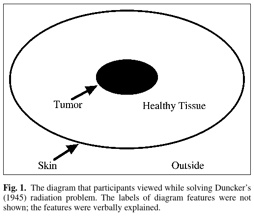Grant, E. R., and Spivey, M. J. Eye movements and problem solving: guiding attention guides thought. Psychological Science 14, 5 (September 2003), 462–466. [pdf]
——-
The main argument of this paper is that attention is not an outcome of cognition but it can help restructure cognition. The paper reports a study of participants solving a radiation problem. The movements of eyes was recorded over the associated image. The authors showed that participants who succesfully completed the task were more likely to look at the external part of the image. Then in a second experiment, the authors changed the graphical salience of this element, thus affecting the completition outcomes. They propose that eye movements patterns correlated with the problem solving process.
Overt visual attention during diagram-based problem solving, as measured by eye movements, has been used in numerous studies to reveal critical aspects of the problem-solving process that traditional measures like solution time and accuracy cannot address. In Experiment 1, we used this methodology to show that particular fixation patterns correlate with success in solving the tumor-and-lasers radiation problem. Given this correlation between attention to a particular diagram feature and problem-solving insight, we investigated participants’ cognitive sensitivity to perceptual changes in that diagram feature. In Experiment 2, we found that perceptually highlighting the critical diagram component, identified in Experiment 1, significantly increased the frequency of correct solutions. Taking a situated perspective on cognition, we suggest that environmentally controlled perceptual properties can guide attention and eye movements in ways that assist in developing problem-solving insights that dramatically improve reasoning.

